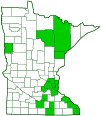crimson clover
(Trifolium incarnatum ssp. incarnatum)
Conservation • Description • Habitat • Ecology • Use • Distribution • Taxonomy
Conservation Status |
|
|||||||
| IUCN Red List | LC - Least Concern |
|||||||
| NatureServe | NNA - Not applicable SNA - Not applicable |
|||||||
| Minnesota | not listed |
|||||||
Description |
||
Crimson clover is an annual forb that rises on a rosette of stems from a taproot. The stems are erect or semi-erect and densely hairy with a few side branches. The leaves are alternate and compound, divided into 3 leaflets. The leaflets are broadly egg-shaped and rounded at the tip. The inflorescence is a head-like cluster at the end of each stem and branch. The flower heads are cone-shaped, pointed, and 1⅛″ to 2″ tall. Each head has up to 75 to 125 flowers. The flowers are pea-like, with 5 petals organized into a banner, 2 wings, and a keel formed by two petals fused together at the tip. The banner is longer than the wings and the keel. The individual flowers are stalkless. The petals are crimson red. The fruit is a seed pod containing a single seed. |
||
Height |
||
6″ to 30″ |
||
Flower Color |
||
Crismon red |
||
Similar Species |
||
Alsike clover (Trifolium hybridum) stems are hairless or nearly hairless. The petals are pale pink to pinkish-white. Red clover (Trifolium pratense) stems are less hairy. The leaflets have a pale V-shaped marking on the upper surface. The petals are pink or magenta. White clover (Trifolium repens ssp. repens) stems are creeping and they root at the nodes. Flowers and leaves are borne on separate stalks. The leaflets have have a pale, crescent-shaped, not V-shaped, marking on the upper surface. The petals are white or white tinted with pink. |
||
Habitat |
||
Disturbed sites. Full or partial sun. |
||
Ecology |
||
Flowering |
||
May to July |
||
Pests and Diseases |
||
|
||
Use |
||
|
||
Distribution |
||||
|
Sources |
|||
| 4/4/2023 | ||||
Nativity |
||||
Native of Europe, Turkey, and Macaronesia. Introduced, cultivated, and naturalized in North America. |
||||
Occurrence |
||||
Rare in Minnesota |
||||
Taxonomy |
|||
| Kingdom | Plantae (green algae and land plants) | ||
| Subkingdom | Viridiplantae (green plants) | ||
| Infrakingdom | Streptophyta (land plants and green algae) | ||
| Superdivision | Embryophyta (land plants) | ||
| Division | Tracheophyta (vascular plants) | ||
| Subdivision | Spermatophytina (seed plants) | ||
| Class | Magnoliopsida (flowering plants) | ||
| Superorder | Rosanae | ||
Order |
Fabales (legumes, milkworts, and allies) | ||
Family |
Fabaceae (legumes) | ||
| Subfamily | Faboideae | ||
| Tribe | Trifolieae |
||
| Genus | Trifolium (clovers) | ||
| Subgenus | Trifolium | ||
| Section | Trifolium | ||
| Species | Trifolium incarnatum (crimson clover) | ||
Subordinate Taxa |
|||
|
|||
Synonyms |
|||
| Trifolium incarnatum var. elatius | |||
Common Names |
|||
carnation clover crimson clover French clover Italian clover scarlet clover |
|||
Visitor Photos |
|||||
Share your photo of this plant. |
|||||
| This button not working for you? Simply email us at info@MinnesotaSeasons.com. Attach one or more photos and, if you like, a caption. |
|||||
|
|||||
MinnesotaSeasons.com Photos |
|||||
|
|||||

Slideshows |
||

Visitor Videos |
|||
Share your video of this plant. |
|||
| This button not working for you? Simply email us at info@MinnesotaSeasons.com. Attach a video, a YouTube link, or a cloud storage link. |
|||
Other Videos |
|||

Visitor Sightings |
|||||
Report a sighting of this plant. |
|||||
| This button not working for you? Simply email us at info@MinnesotaSeasons.com. Be sure to include a location. |
|||||
|
|||||
MinnesotaSeasons.com Sightings |
|||||
|
|||||

|
Created: Last Updated: © MinnesotaSeasons.com. All rights reserved. |
